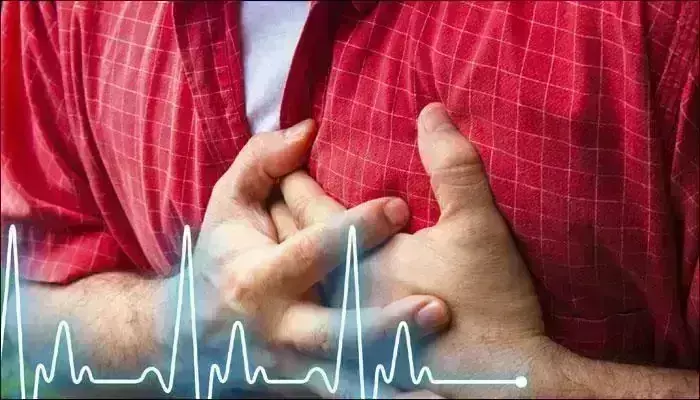- Home
- Medical news & Guidelines
- Anesthesiology
- Cardiology and CTVS
- Critical Care
- Dentistry
- Dermatology
- Diabetes and Endocrinology
- ENT
- Gastroenterology
- Medicine
- Nephrology
- Neurology
- Obstretics-Gynaecology
- Oncology
- Ophthalmology
- Orthopaedics
- Pediatrics-Neonatology
- Psychiatry
- Pulmonology
- Radiology
- Surgery
- Urology
- Laboratory Medicine
- Diet
- Nursing
- Paramedical
- Physiotherapy
- Health news
- Fact Check
- Bone Health Fact Check
- Brain Health Fact Check
- Cancer Related Fact Check
- Child Care Fact Check
- Dental and oral health fact check
- Diabetes and metabolic health fact check
- Diet and Nutrition Fact Check
- Eye and ENT Care Fact Check
- Fitness fact check
- Gut health fact check
- Heart health fact check
- Kidney health fact check
- Medical education fact check
- Men's health fact check
- Respiratory fact check
- Skin and hair care fact check
- Vaccine and Immunization fact check
- Women's health fact check
- AYUSH
- State News
- Andaman and Nicobar Islands
- Andhra Pradesh
- Arunachal Pradesh
- Assam
- Bihar
- Chandigarh
- Chattisgarh
- Dadra and Nagar Haveli
- Daman and Diu
- Delhi
- Goa
- Gujarat
- Haryana
- Himachal Pradesh
- Jammu & Kashmir
- Jharkhand
- Karnataka
- Kerala
- Ladakh
- Lakshadweep
- Madhya Pradesh
- Maharashtra
- Manipur
- Meghalaya
- Mizoram
- Nagaland
- Odisha
- Puducherry
- Punjab
- Rajasthan
- Sikkim
- Tamil Nadu
- Telangana
- Tripura
- Uttar Pradesh
- Uttrakhand
- West Bengal
- Medical Education
- Industry
Target O2 saturation of 90-94% fails to improve survival in out-of-hospital Cardiac Arrest resuscitation

The EXACT randomized trial found that patients having an out-of-hospital cardiac arrest and achieving the return of spontaneous circulation with an oxygen saturation of 90% to 94% did not have an improved survival rate when compared with 98% to 100% oxygen saturation until admission to the intensive care unit. The trial results were published in the journal JAMA Network.
In out-of-hospital cardiac arrest, the administration of a high oxygen concentration following spontaneous circulation recovery may increase reperfusion brain injury. Researchers conducted a trial to determine whether targeting a lower oxygen saturation in the early phase of post-resuscitation care for out-of-hospital cardiac arrest improves survival at hospital discharge.
Between December 11, 2017, and August 11, 2020, a multicenter, parallel-group randomized clinical trial was done on unconscious adults with the return of spontaneous circulation and peripheral oxygen saturation (Spo2) of at least 95% while receiving 100% oxygen at 2 emergency medical services and 15 hospitals in Victoria and South Australia, Australia. Data was collected from ambulance and hospital medical records. 428 patients enrolled in the trial were randomized by paramedics to two groups of Intervention group with 216 patients and a standard care group with 212 patients. They received oxygen titration to achieve an oxygen saturation of either 90% to 94% in the intervention group or 98% to 100% in the standard care group until arrival in the intensive care unit. The primary outcome was survival until discharge from the hospital. Hypoxic episodes (Spo2 90%) and prespecified serious adverse events, such as hypoxia with rearrest, were among the nine secondary outcomes gathered.
Results:
- Of the 428 randomized patients, 425 were included in the primary analysis with median age, of 65.5 years and 100 [23.5%] females and all completed the trial.
- Overall, 82 of 214 patients (38.3%) in the intervention group survived hospital discharge compared with 101 of 211 (47.9%) in the standard care group (difference, −9.6%).
- 8 showed no significant difference, between the 9 prespecified secondary outcomes collected during a hospital stay.
- 31.3% (n = 67) of participants in the intervention group and 16.1% (n = 34) in the standard care group showed a hypoxic episode before intensive care.
Though the trial was terminated early due to the COVID-19 pandemic, the trial results do not support the use of a 90% to 94% oxygen saturation target in the out-of-hospital setting after resuscitation from cardiac arrest.
Further reading: Bernard SA, Bray JE, Smith K, et al. Effect of Lower vs Higher Oxygen Saturation Targets on Survival to Hospital Discharge Among Patients Resuscitated After Out-of-Hospital Cardiac Arrest: The EXACT Randomized Clinical Trial. JAMA. Published online October 26, 2022.
BDS, MDS
Dr.Niharika Harsha B (BDS,MDS) completed her BDS from Govt Dental College, Hyderabad and MDS from Dr.NTR University of health sciences(Now Kaloji Rao University). She has 4 years of private dental practice and worked for 2 years as Consultant Oral Radiologist at a Dental Imaging Centre in Hyderabad. She worked as Research Assistant and scientific writer in the development of Oral Anti cancer screening device with her seniors. She has a deep intriguing wish in writing highly engaging, captivating and informative medical content for a wider audience. She can be contacted at editorial@medicaldialogues.in.
Dr Kamal Kant Kohli-MBBS, DTCD- a chest specialist with more than 30 years of practice and a flair for writing clinical articles, Dr Kamal Kant Kohli joined Medical Dialogues as a Chief Editor of Medical News. Besides writing articles, as an editor, he proofreads and verifies all the medical content published on Medical Dialogues including those coming from journals, studies,medical conferences,guidelines etc. Email: drkohli@medicaldialogues.in. Contact no. 011-43720751




